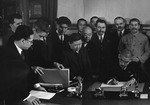Soviet-Japanese Neutrality Pact
Contributor: C. Peter Chen
ww2dbaseThe Soviet–Japanese Neutrality Pact was signed between the Soviet Union and Japan two years after the war between USSR and Japan in China (on the border of puppet states Manchukuo and Mongolian People's Republic) slowed inconclusively. The treaty called for the two nations to observe neutrality when any one of the two signing nations was invaded by a third nation. Both nations also pledged to respect the sovereignty of the two puppet states carved out of Chinese territory.
ww2dbaseAlthough Chinese territory was involved in the form of the two puppet states, there was no Chinese representation at the negotiations.
ww2dbaseFull text of the treaty is as follows:
ww2dbaseThe Presidium of the Supreme Soviet of the Union of Soviet Socialist Republics and His Majesty the Emperor of Japan, guided by a desire to strengthen peaceful and friendly relations between the two countries, have decided to conclude a pact on neutrality, for which purpose they have appointed as their Representatives:
- The Presidium of the Supreme Soviet of the Union of Soviet Socialist Republics - Vyacheslav Mikhailovich Molotov, Chairman of the Council of People's Commissars and People's Commissar of Foreign Affairs of the Union of Soviet Socialist Republics;
- His Majesty the Emperor of Japan - Yosuke Matsuoka, Minister of Foreign Affairs, Jusanmin, Cavalier of the Order of the Sacred Treasure of the First Class, and Yoshitsugu Tatekawa, Ambassador Extraordinary and Plenipotentiary to the Union of Soviet Socialist Republics, Lieutenant General, Jusanmin, Cavalier of the Order of the Rising Sun of the First Class and the Order of the Golden Kite of the Fourth Class,
ww2dbasewho, after an exchange of their credentials, which were found in due and proper form, have agreed on the following:
- Article one: Both Contracting Parties undertake to maintain peaceful and friendly relations between them and mutually respect the territorial integrity and inviolability of the other Contracting Party.
- Article two: Should one of the Contracting Parties become the object of hostilities on the part of one or several third powers, the other Contracting Party will observe neutrality throughout the duration of the conflict.
- Article three: The present Pact comes into force from the day of its ratification by both Contracting Parties and remains valid for five years. In case neither of the Contracting Parties denounces the Pact one year before the expiration of the term, it will be considered automatically prolonged for the next five years.
- Article four: The present Pact is subject to ratification as soon as possible. The instruments of ratification shall be exchanged in Tokyo, also as soon as possible.
ww2dbaseIn confirmation whereof the above-named Representatives have signed the present Pact in two copies, drawn up in the Russian and Japanese languages, and affixed thereto their seals. Done in Moscow on April 13, 1941, which corresponds to the 13th day of the fourth month of the 16th year of Showa.
- V. Molotov
- Yosuke Matsuoka
- Yoshitsugu Tatekawa
ww2dbaseWhen Germany invaded the Soviet Union later that year, the Japanese entertained the idea of violating the treaty and cooperatively invade eastern Russia, but in the end they upheld their end of the bargain and turn their ambition toward the Pacific instead. The Soviet Union, on the other hand, considered breaking this pact ever since they started turning the German invasion back. On 5 Apr 1945, the Soviets informed the Japanese that they were enacting article three of the pact which allowed either party to elect to not renew the pact when it would become expired on 13 Apr 1946. As the result of secret negotiations between USSR and the Western Powers, USSR would eventually violate the pact by declaring war on Japan in Aug 1945.
ww2dbaseSource: Wikipedia.
Last Major Update: May 2007
Photographs
 |  |
Soviet-Japanese Neutrality Pact Timeline
| 29 Mar 1941 | Japanese Foreign Minister Yosuke Matsuoka again met with German Foreign Minister Joachim von Ribbentrop in Berlin, Germany. Ribbentrop offered Matsuoka that, should the Soviet Union attack Japan while Japan embarked on a military campaign against British possessions in Asia, Germany would lend military assistance. Matsuoka countered, noting that the Soviet Union seemed to be friendly toward Japan. |
| 13 Apr 1941 | Soviet Union and Japan signed a 5-year neutrality pact. In Moscow, Russia, German ambassador Friedrich Werner von der Schulenburg reported that Joseph Stalin was unexpectedly friendly to both Japanese and German diplomats on this date. |
| 5 Apr 1945 | Soviet foreign minister Molotov informed the Japanese ambassador that the Soviet Union would not renew the Soviet-Japanese Neutrality Pact when it would expire in 1946. |
Please consider supporting us on Patreon. Even $1 per month will go a long way! Thank you. Please help us spread the word: Stay updated with WW2DB: |
Visitor Submitted Comments
All visitor submitted comments are opinions of those making the submissions and do not reflect views of WW2DB.

» Matsuoka, Yosuke
» Molotov, Vyacheslav
» Stalin, Joseph
» Tatekawa, Yoshitsugu
Location:
» Russia
 |  |
- » 1,177 biographies
- » 337 events
- » 44,933 timeline entries
- » 1,245 ships
- » 350 aircraft models
- » 207 vehicle models
- » 376 weapon models
- » 123 historical documents
- » 261 facilities
- » 470 book reviews
- » 28,476 photos
- » 365 maps
Joachim von Ribbentrop, German Foreign Minister, Aug 1939
15 Jul 2023 08:26:37 AM
I wonder if it's possible to get more detailed information about this matter. For example did Japanese cargo planes fly across Russia and go to Europe and also neutral countries like Turkey? I wish that there was much more informative and detailed articles on this matter, on the molotov Matroska pact. Since Japan honored it's neutrality pact and allowed Russian cargo ships to go through the pacific, did Russia also reciprocate this generosity of Japan by allowing Japanese cargo planes to fly across Russian territory?